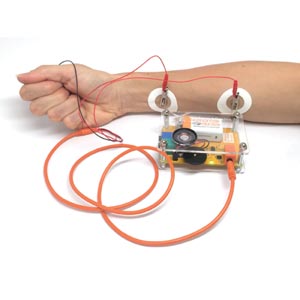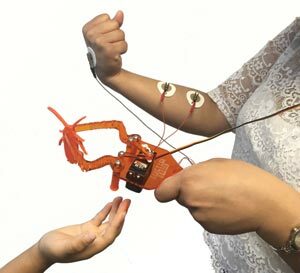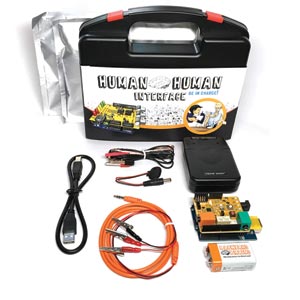 By Ted Beyer
By Ted Beyer
Though they are buzzwords, STEM and STEAM have a real purpose. We all want to get this cross-discipline learning into our classrooms as soon as possible. Yet we often run into a trade off between the desire for MORE and the reality of budgets.
Recently, here at Educational Innovations, we came across one of the most compelling and astonishing product lines we have ever seen. Coming from a company with the unassuming name of Backyard Brains, the level of learning and exploration packed into a cost effective box is just incredible.
Introducing Neuroscience from Backyard Brains
The founders, a group of Neuroscience PhDs, have opened the door to an exciting area of science. A place where the brain, electronics and the real world all intersect—at a price point that is in reach for everyone. As they say, they started with one simple and slightly laughable goal: to turn a $40,000+ rack of graduate level electronics into a $100 kit that students could use in the classroom to perform real, hands-on neuroscience experiments. The awesome thing is… they did it—and more!
 Their basic product is called The Muscle SpikerBox. I’ll admit, “SpikerBox” sounds like a container full of nails. Actually, it has that name because they record “spikes!” Spikes are action potentials. These are the universal signals which bring life to thought, sensation, movement, behavior, actions, and reactions… In other words, everything that makes living things living things!
Their basic product is called The Muscle SpikerBox. I’ll admit, “SpikerBox” sounds like a container full of nails. Actually, it has that name because they record “spikes!” Spikes are action potentials. These are the universal signals which bring life to thought, sensation, movement, behavior, actions, and reactions… In other words, everything that makes living things living things!
Teachers we work with are excited to bring this kind of sophisticated hands-on science experiments into their classrooms. Naturally, every kit comes complete with customized educational materials. There’s the Spike Recording software (called… yup, SpikeRecorder) that lets you use the tech you already have (Chromebooks, iPads, PC, Android Phones) to record and analyze the signals your SpikerBox is recording.
So, what are these boxes looking at? The Muscle SpikerBox records EMGs, also known as electromyograms. Huh? EMGs are recordings of the electrical activity in our muscles! When your brain sends a signal commanding your muscles to move, an electrical synapse fires where the nerve meets the muscle, and the Spiker Box’s sensors record that! Used in Medicine, Sports Science, and Physiology, EMGs are an exciting way to introduce students to practical science where they are the experiment. For example, a great first experiment is recording varying rates of muscle fatigue. In fact, recently a fifth grader won her district Science Fair by comparing muscle fatigue between her left and right arms.
Even More Neuroscience!
 But the Muscle SpikerBox is just the beginning. Now that you can see your body’s electrical activity, what can you do with it? Our friends at Backyard Brains offer another kit called The Claw Bundle. This one takes your nerve impulses and uses them to actuate a servo motor. That motor, in turn, closes (you guessed it) a claw. This uses a more sophisticated control box which includes and Arduino computer. If you or your students are handy, you could use this device to control things other than the included claw assembly. Or you could re-write the code to make the claw behave differently. It is this technology that is being used to create artificial limbs for amputees.
But the Muscle SpikerBox is just the beginning. Now that you can see your body’s electrical activity, what can you do with it? Our friends at Backyard Brains offer another kit called The Claw Bundle. This one takes your nerve impulses and uses them to actuate a servo motor. That motor, in turn, closes (you guessed it) a claw. This uses a more sophisticated control box which includes and Arduino computer. If you or your students are handy, you could use this device to control things other than the included claw assembly. Or you could re-write the code to make the claw behave differently. It is this technology that is being used to create artificial limbs for amputees.
But Wait… There’s MORE!
 Of course, if you plan on taking over the world, you can move to The Human-to-Human Interface Bundle. This is pretty much what it sounds like. You can flex your arm, and your partner’s body will react to that. Where you place the electrodes will determine what that action is, but most often it causes them to roughly mimic your own actions. This opens up entire new vistas of exploration—the ability for one human’s nervous system to take over parts of another person. It invites all sorts of experimental possibilities. The Human-to-Human Interface uses the same Arduino “brain” as the Claw with some additional outboard gear, and, of course, all new code. You can read more about it here.
Of course, if you plan on taking over the world, you can move to The Human-to-Human Interface Bundle. This is pretty much what it sounds like. You can flex your arm, and your partner’s body will react to that. Where you place the electrodes will determine what that action is, but most often it causes them to roughly mimic your own actions. This opens up entire new vistas of exploration—the ability for one human’s nervous system to take over parts of another person. It invites all sorts of experimental possibilities. The Human-to-Human Interface uses the same Arduino “brain” as the Claw with some additional outboard gear, and, of course, all new code. You can read more about it here.
More Backyard Brains products are coming out all the time! Keep checking here. We are thrilled to be able to carry this state-of-the-art, affordable line of biofeedback materials. These neuroscience devices are some of the most innovative and unique materials we have seen in years. They open connections between biology and engineering that were just not possible before at anything like this price point!


This entry was posted on Friday, December 27th, 2019 at 5:47 am and is filed under Biology, College level, High School level, life science, Middle School level. You can follow any responses to this entry through the RSS 2.0 feed. You can leave a response, or trackback from your own site.